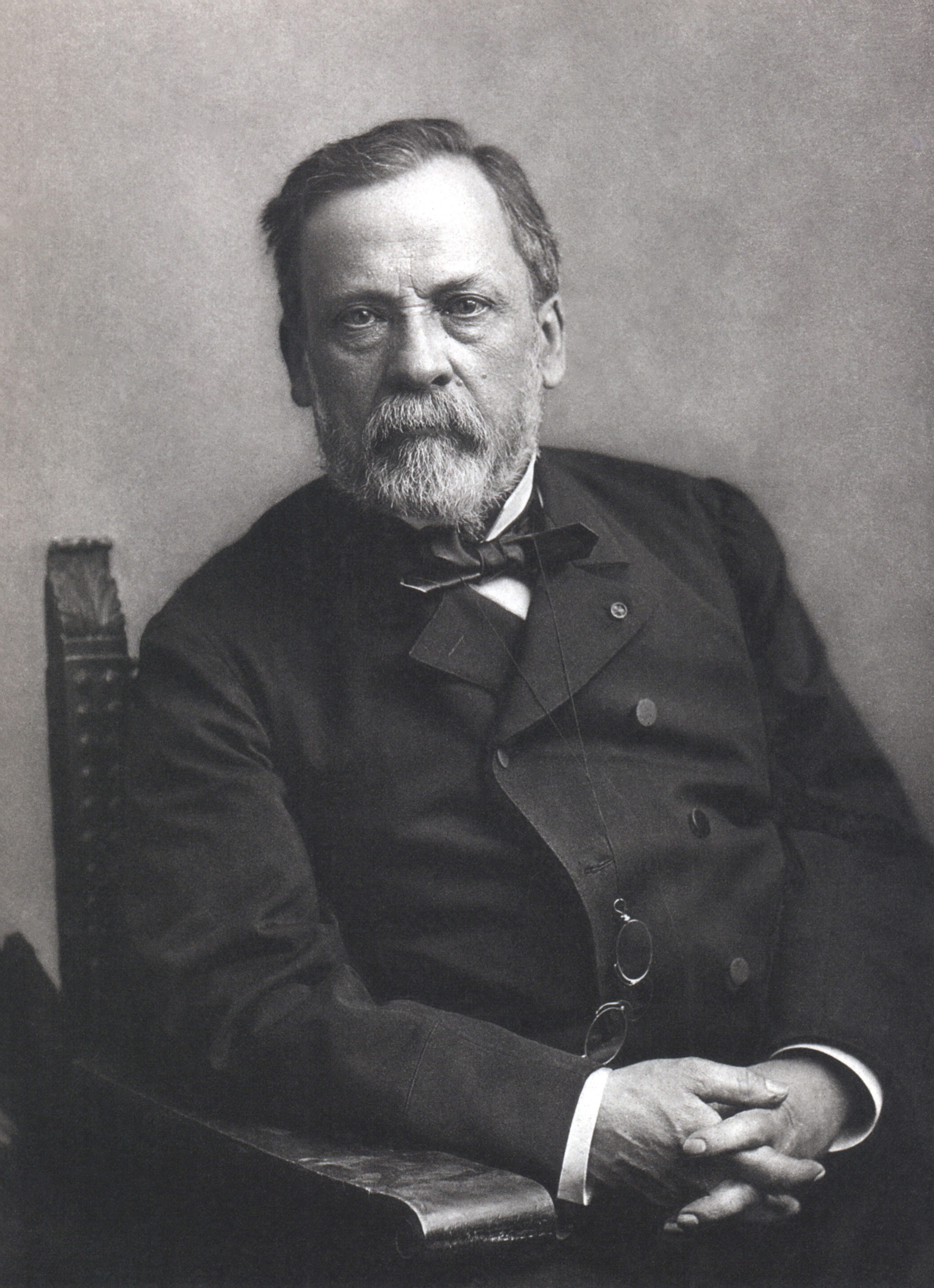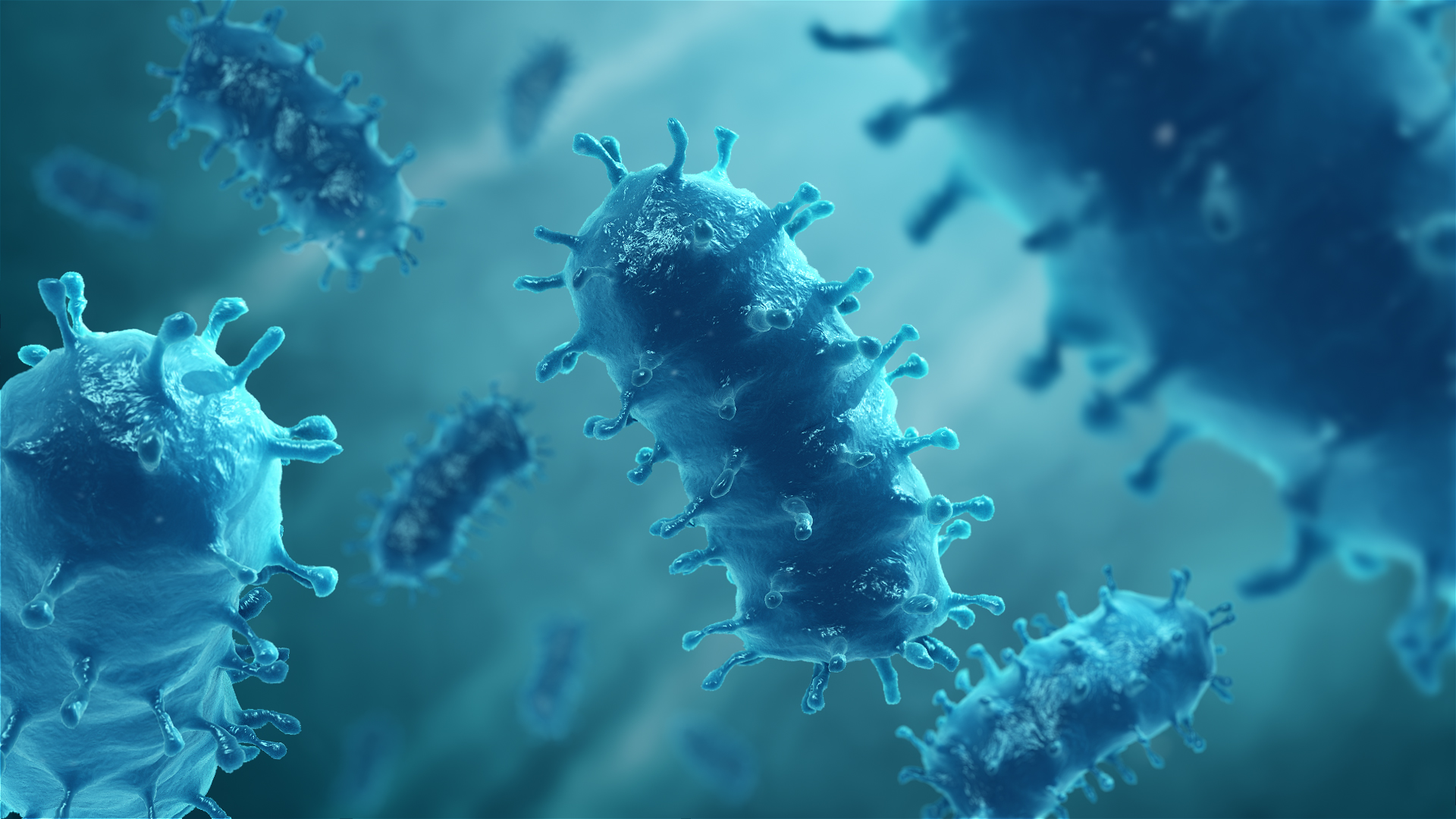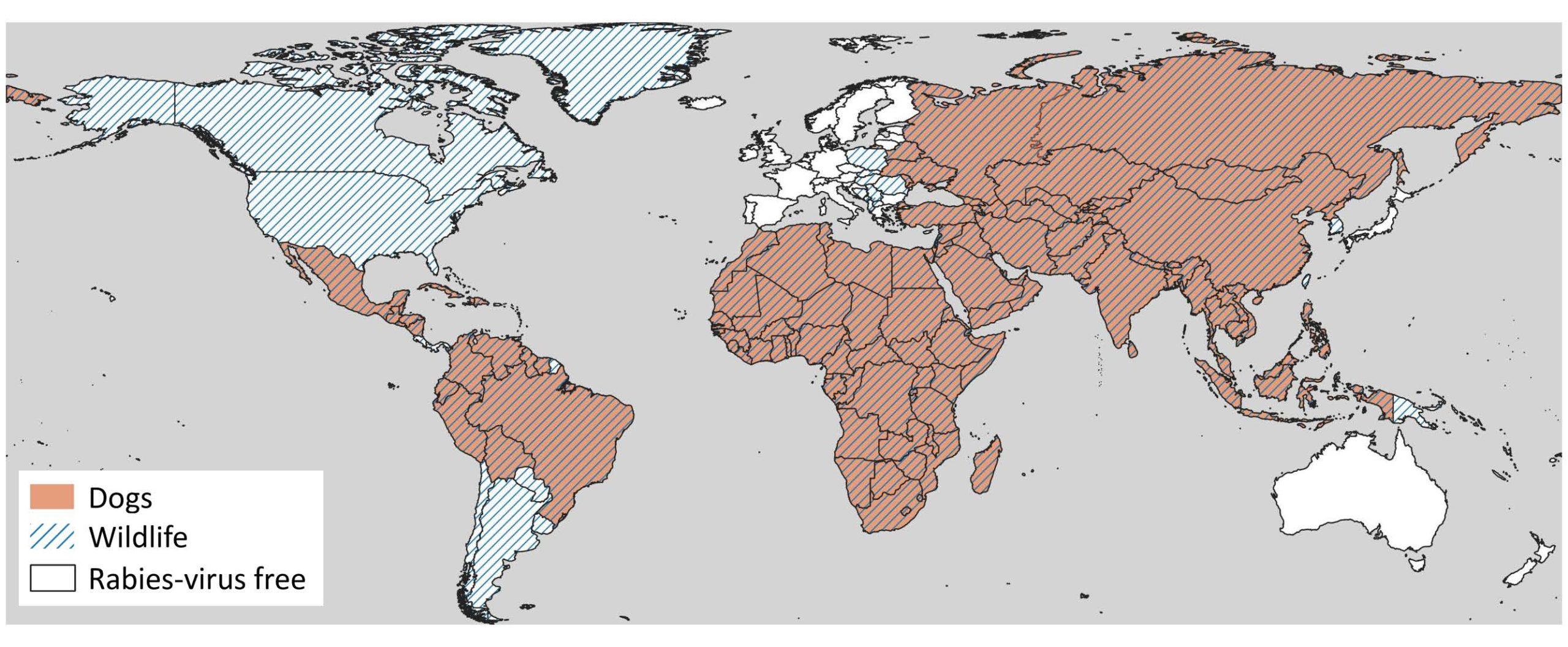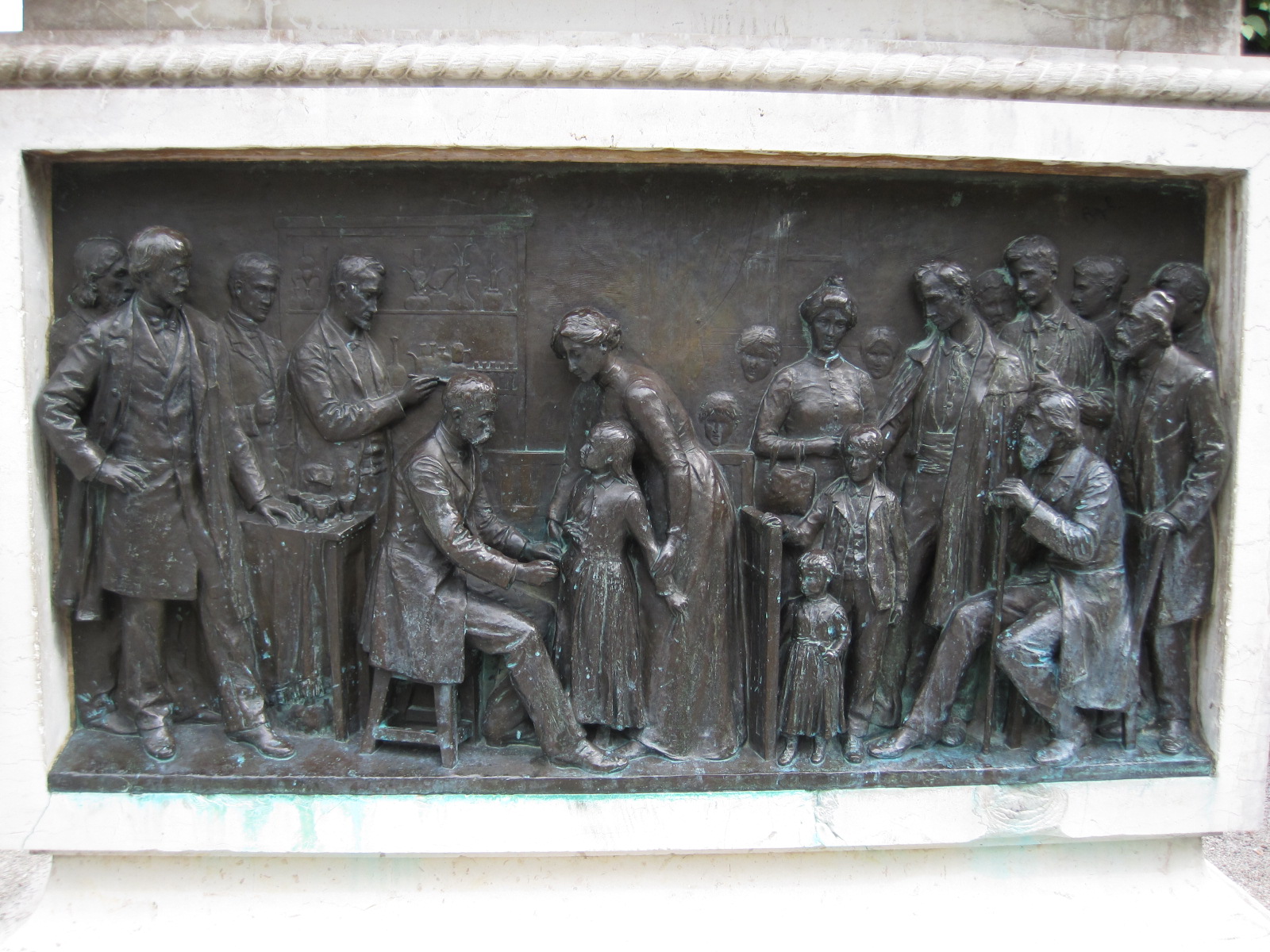
Credit: Paul Nadar, public domain, via Wikimedia Commons
Background
Synopsis: Rabies can infect all warm-blooded animals, including humans. Without treatment, it almost always results in death. Louis Pasteur’s work on germ theory and disease led to the life-saving vaccine for rabies.
- Rabies is a disease that can be contracted by all warm-blooded animals and is transferred through bodily fluids. This usually happens when an infected animal’s saliva enters the bloodstream through a bite but can also be through any bodily fluid contacting mucous membranes like the nose or mouth.

A still image from a 3D animation of the rabies virus. The virus has a length of about 180 nanometers or 180 x 10-9 meters, half the width of a human hair
Credit: Scientificanimations.com/, CC BY-SA 4.0, via Wikimedia Commons- The first signs of rabies aren’t visible for days to months after the initial infection, with a lengthy incubation stage leading to flu-like symptoms such as fever and nausea. Then, cognitive and neurological effects occur, including paralysis, aggression, and confusion, which then leads to a coma and eventually death from brain inflammation.
- Rabies has a near 100% mortality rate without vaccination or immediate treatment.
- Rabies kills approximately 59,000 people worldwide each year and is a significant threat in countries with limited access to vaccines, especially in Africa and Asia.
- In contrast, rabies is rare in the US, largely due to widespread pet vaccination and immediate treatment protocols, with only about 1-3 deaths annually.
- The most common carriers of rabies are dogs, foxes, raccoons, skunks, coyotes, and bats. Experts recommend getting the vaccine after any contact with bats. The easiest way to prevent infection is to avoid animals that are acting strangely or look sick, and to avoid feeding wildlife altogether.
- Mass animal vaccination is the most effective strategy to reduce rabies cases, with most domesticated animals and pets receiving a rabies booster once a year.
- Pre-exposure vaccines are available for those at high risk (e.g., veterinarians; travelers to high-risk areas).
- Post-exposure vaccines, administered after a possible bite or other transmission, include rabies antibodies to provide immediate protection.

Infected dogs are the most common source of rabies across the globe. This has been mostly eliminated in the Western Hemisphere, although the Caribbean nation of Haiti has the most dog-mediated human deaths from rabies worldwide, averaging approximately 130 deaths per year.
Credit: Centers for Disease Control, public domain
- Louis Pasteur, credited with germ theory and the inventor of the method of sanitizing beverages called pasteurization, is one of the most well-known microbiologists in the world.
- Born in 1822, he earned a bachelor’s degree in both art and science, and a doctorate before starting a career in chemistry.
- After noticing that wine, beer, and milk often spoiled, Pasteur discovered that heating these beverages to a specific temperature killed the harmful microorganisms responsible for spoilage.
- Once boiled and sealed to prevent exposure to air or dust (which could reintroduce contaminants), the beverages remained fresh for much longer.
- This groundbreaking preservation technique was named “pasteurization” in his honor and laid the foundation for safer food and drink production.
- With this success, Pasteur turned his attention to studying infectious diseases.
- Pasteur made enormous progress in the field of immunology, creating vaccines for anthrax, cholera, and rabies, becoming incredibly well known in the process.
- After successfully identifying and culturing cholera bacteria in 1878, he discovered that older strains were practically harmless and that chickens injected with them would no longer be susceptible to the newer, deadly strain.
- Pasteur then moved on to the bacterium Bacillus anthracis, commonly known as anthrax, which affects cows, sheep and goats. Here, he developed the concept of using weakened versions of microbes in vaccines to immunize against a disease.
- Next, he tackled rabies. Discovering that the dried spinal cords of animals who died of the virus produced a weakened version of it, he gradually exposed dogs to it and saw that they were immunized.
- The first human patient for his vaccine was a nine-year-old French boy, bitten by a rabid dog. After several rounds of injections over a few weeks, the boy survived and made international headlines, opening the door for widespread use of the vaccine in 1885, dramatically reducing the death toll of rabies across the world.

A bronze sculpture on the base of a monument to Pasteur at his home in Arbois, France, depicts his work in healthcare.
Credit: Arnaud 25, CC BY-SA 3.0, via Wikimedia Commons
- Louis Pasteur is considered the father of microbiology, microscopically examining the natural world, leading to many new discoveries and combating disease through vaccines still used today.
- When you get a vaccine, it exposes your immune system to a safe version of a germ—this could be a weakened, inactivated, or just a small part of the germ. Your immune system detects this and creates antibodies to fight it off, learning how to protect you in the process.
- Later, if you’re exposed to the full-strength pathogen, your immune system “remembers” it and can respond much faster. This quick response helps destroy the illness before it can make you sick.
- The rabies vaccine works slightly differently. If you’ve been bitten by an animal that might have rabies, you need immediate protection.
- Instead of just teaching your immune system, the post-exposure rabies vaccine includes ready-made antibodies that attack the rabies virus right away. This gives your body time to make its own antibodies, which provide longer-lasting protection.
While rabies has been largely controlled in some regions, it remains a severe threat in many others. Organizations like the World Health Organization (WHO) and Global Alliance for Rabies Control are working toward the goal of zero rabies deaths by 2030.
Episode script
Rabies is almost 100% fatal. It can affect any warm-blooded creature and is transferred by any bodily fluid – though most commonly by a bite that passes saliva from the infected animal to the blood of another.
It takes days or even months for the virus to incubate. But once active, it attacks the nervous system causing paralysis, coma and eventually death.
Rabies kills 60,000 people annually worldwide, mostly in Africa and Asia. Before the 19th century, it was far more deadly, because there was no treatment.
Then came Louis Pasteur. First, he invented the process to sterilize milk and other liquids, by heating them near boiling to kill bacteria.
Next, he focused on diseases, beginning with cholera. He cultured it in a lab, then discovered that chickens injected with older strains weren’t affected by the disease – and were immunized against new strains.
He developed a similar treatment for anthrax, which often infected livestock, then moved on to rabies.
He found that the dried spinal cords of animals killed by the disease contained a weak version that could be injected to immunize against the live virus.
Thanks to Pasteur, rabies has been almost completely eradicated in the US, with several organizations aiming for zero cases worldwide by 2030.
Do your part by vaccinating your pets, and yourself, if bitten, or traveling to areas where rabies is still endemic.

